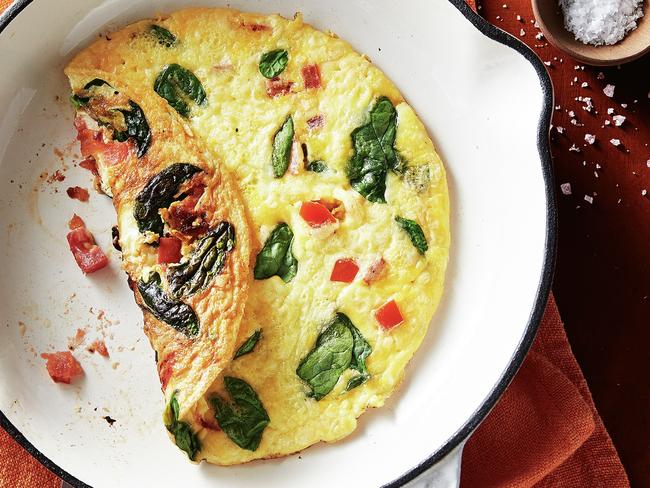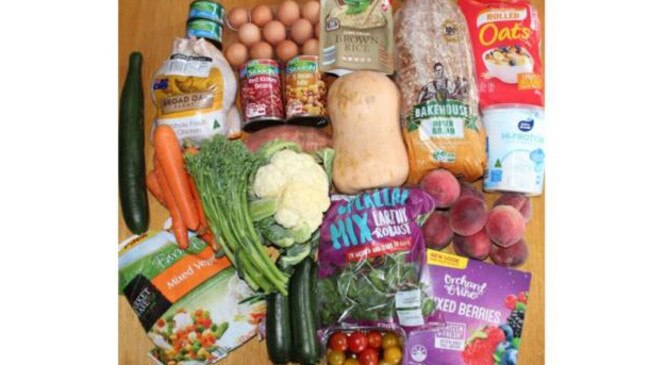The healthy haul you can get at ALDI for $50
CAN you be healthy on the cheap? We challenged a dietitian to spend $50 in ALDI. Some of her purchases may surprise you.
THINK BACK to the last time you did a big grocery shop. You probably spent well over $100 and have since made some return visits to top up your food supplies.
While you keep hearing health experts say “it isn’t expensive to eat healthily”, you’ve also seen the price of acai bowls and gluten free bread.
myBody+Soul wanted to find out if eating affordably and healthily can be done, so sent me (a dietitian) to discount supermarket, ALDI with $50 to see what I would buy.
Some of my purchases might just surprise you — there were certainly no fancy “superfoods” or overpriced items in my shopping trolley.

Get the basics right
Contrary to popular belief, it’s not hard to stick to a balanced diet. Eat a variety of foods mostly from the five core food groups, try to have half a plate of veggies at your main meals and enjoy energy-dense, nutrient-poor foods (think chocolate, chips and biscuits) in moderation and only occasionally.
And that’s exactly what your shopping trolley should reflect.
* For more articles like this, head to body+soul
My supermarket haul was roughly half fruit and veggies — mostly fresh, in-season produce. It’s important to shop with the seasons (rather than going for your boring old combo of carrot, broccoli and corn each week) for two main reasons.
The first is that it provides you with a range of vitamins, minerals and antioxidants all year round. You see, each different colour fruit and vegetable contains their own unique set of nutrients and antioxidants — and unless you rotate your choices as the year passes by, you’re selling yourself short.
The second reason is it will save you money in the long run. In season = readily available = prices drop. It’s just basic economics.
I also purchased some frozen varieties for convenience and again to cut costs. Frozen veggies are actually just as nutritious as their fresh counterparts; they are often snap-frozen as soon as they are picked and so retain their nutritional value. Plus they make for a quick and easy stir-fry when you’re not in the mood to do much cooking.
Same goes for frozen berries with yoghurt or oats for breakfast, too.

What about protein?
I chose a few different options — a whole fresh chicken, tuna and eggs. My two tins of tuna were in spring water, but you could buy tuna in oil or flavoured if you like. For simplicity, I chose spring water so that the tuna can be flavoured with whatever else it’s eaten with. My dozen eggs were also free-range, but that’s just a personal preference. Having a few different protein options like these means you won’t get bored and a bonus is that each of these proteins is suited to a variety of dishes.
You could roast a chook for dinner one night, and use the left overs on sandwiches throughout the week.
You could have a tuna sandwich for a lunch or two, or add it to a salad for a protein punch.
My personal favourite is the humble egg. Poached, scrambled, in omelets, frittatas, sandwiches or salads … the list goes on. Not only are eggs super versatile, they are economical (at just $0.60 for a single serve of protein), they are a ‘complete’ protein, which means they contain all the essential amino acids and are very high quality, and they come loaded with a range of micronutrients nutrients, too. Just don’t have more than 6 a week and you have nothing to worry about.
Legumes like beans count as both protein and vegetables — which is why these natural superfoods tend to be a dietitian’s favourite. Again, they’re cheap (only $0.73 per tin) and are a high-fibre option to support a healthy gut.

Grains
You also can’t forget the importance of grains — wholegrains in particular. I purchased multigrain bread, brown rice and rolled oats.
Grains are particularly important for B-group vitamins and fibre. In fact, most people between the ages of 19-50 years are recommended to have 6 serves a day.
Dairy
Finally, dairy is my go-to snack — I can’t go past some yoghurt and berries to beat the 3pm slump. Yoghurt was the most expensive item on my list (at $4.99 for 1kg) but I think the investment is well worth it. Not only does yoghurt provide that all-important calcium for healthy bones and teeth, it comes as a complete package with a range of other vitamins and minerals and is good for your gut, too.
Milk is another great source of protein and calcium (as well as a string of other essential vitamins and minerals) — I always have cow’s milk in my fridge so simply didn’t purchase it on this occasion. If you prefer to have a plant-based milk, ensure it is fortified with calcium.
You might be surprised to find out that I steer clear of organic items. For one, they cost a bomb and for two — I just don’t see the need for it.
Tying it all together
With a few basic ingredients that would be lying in your pantry, there really is a multitude of meals that you could make with this basket of goodies.
For breakfast, you could have oats with yoghurt and berries, a veggie omelet or some eggs on toast with a side of roasted tomatoes.
For lunch, sandwiches, salads and leftovers from dinner would be my approach.
And for dinner, a whole-roasted chicken, a stir-fry, a frittata or a soup would be my best picks.
Snacks often make or break a diet — but with these ingredients in your fridge and pantry you’re covered on the snack front as well. Yoghurt and fruit is my favourite snack, but you could also have some veggie sticks with a wholesome dip like tzatziki.
My experience
Overall my shop at ALDI was fruitful (pardon the pun) and economical. While some of my choices were limited, you could definitely save a few dollars and have a nutritious and delicious meal plan.
And just to prove it, here is my shopping list:
Fruit and Veggies = $27.52
Broccolini = $1.69
Continental cucumber = $0.99
Carrots = $1.49
Cauliflower = $3.99
Salad leaf mix = $1.99
Tomato medley = $2
Zucchini = $1.49
Butternut pumpkin = $3.49
Sweet potato = $2.11
Frozen mixed berries, 500g = $3.69
Peaches, 1kg = $3
Frozen mixed vegetables, 1kg = $1.59
Protein = $13.20
Whole chicken = $5.97
Dozen eggs = $3.59
Can of red kidney beans = $0.73
Can of 5 bean mix = $0.73
2 tins of tuna in spring water ($1.09 ea) = $2.18
Dairy = $4.99
Yoghurt = $4.99
Grains = $4.76
Microwave brown rice = $1.39
Rolled oats, 750g = $1.08
Mixed grain bread = $2.29
Total = $50.47
(OK, so it’s wasn’t $50 exactly, but close enough).
Melissa Meier is a Sydney-based dietitian. You can follow her @honest_nutrition.




